Screen Sense: Creating Healthy Digital Habits for Children
In today’s interconnected world, children are growing up surrounded by screens from an early age. While digital technology offers tremendous educational and entertainment opportunities, finding the right balance has become increasingly crucial for healthy development. This comprehensive guide provides practical strategies to help families navigate the digital landscape mindfully. From creating tech-free zones to fostering nature connections, these evidence-based approaches will help you establish healthy digital habits that support your child’s wellbeing while still embracing the benefits technology can offer. By implementing these strategies, you can help your children develop a healthy relationship with screens that will serve them throughout life.
Table of Contents
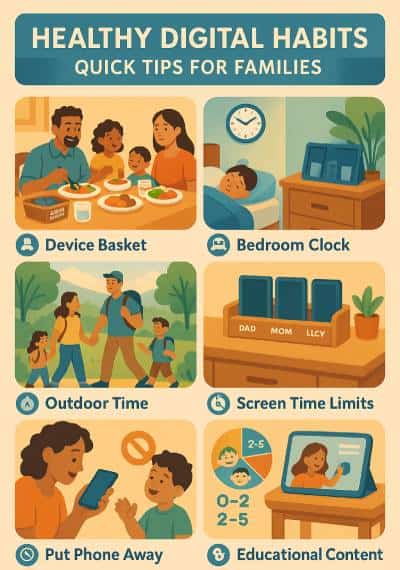 Quick Action Tips for Parents
Quick Action Tips for Parents
- Create tech-free zones & times:
Designate device-free meals, screen-free bedrooms, and 1-2 hours before bedtime
- Centralise device storage:
Set up a common area charging station away from bedrooms
- Balance screens with nature:
Prioritise daily “green time” outdoors to buffer digital effects
- Model healthy habits:
Put your own devices away during family activities
- Set age-appropriate limits:
Follow health guidelines:
under 2s (no screen time except video chat),
2-5 years (max 1 hour/day),
5-17 years (max 2 hours recreational screen time/day)
For more granular breakdown See “Screen Time Rules for Kids: Age-by-Age Guide for Parents“.
- Focus on quality:
Choose educational, interactive content over passive viewing
- Create visual schedules:
Use clocks, timers and charts to make screen time predictable
Consider “Screen Time Management“: a Point & Reward System aimed at developing healthy habits.This point system empowers parents by encouraging children to complete their chores, homework, and similar tasks, while giving children a structured reward such as a dedicated screen time.
- Establish engaging alternatives:
Set up accessible craft supplies, books, games, and outdoor equipment
- Co-view and discuss:
Watch together and talk about content, especially with younger children
- Teach digital literacy:
Help children understand media messages, recognise advertising, and question online information
Creating a Balanced Digital Environment for Children
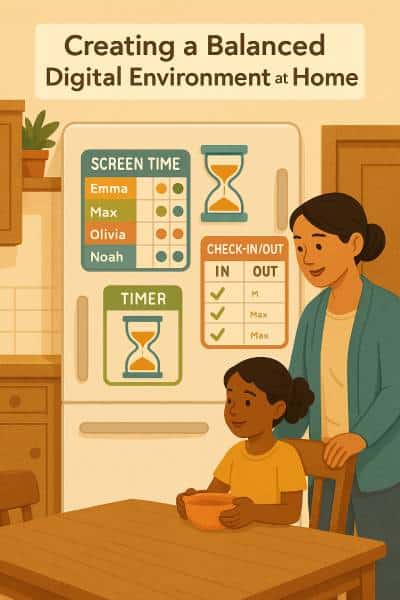 The physical environment of your home plays a crucial role in shaping healthy digital habits. By thoughtfully arranging your living spaces, you can create natural boundaries for technology use while fostering alternatives that engage children’s imagination and curiosity. These practical home environment strategies transform abstract screen time guidelines into concrete, visible systems that the entire family can follow. From centralised device management to dedicated nature connections, these approaches help create a home atmosphere where technology serves as a tool rather than a constant presence, allowing for more mindful and intentional digital engagement.
The physical environment of your home plays a crucial role in shaping healthy digital habits. By thoughtfully arranging your living spaces, you can create natural boundaries for technology use while fostering alternatives that engage children’s imagination and curiosity. These practical home environment strategies transform abstract screen time guidelines into concrete, visible systems that the entire family can follow. From centralised device management to dedicated nature connections, these approaches help create a home atmosphere where technology serves as a tool rather than a constant presence, allowing for more mindful and intentional digital engagement.
Home Environment Strategies
-
Centralised Device Hub
- Create a specific location for storing and charging all family devices
- Keep this hub in a common area, not in bedrooms
- Establish clear times when devices should be returned to the hub
-
Visual Management Tools
- Use visual timers that show time remaining in a concrete way
- Create charts showing agreed screen time schedules
- Implement a visual “check-in/check-out” system for devices
- Our Screen Time Management app is being updated, join our newsletter to stay informed here.
-
Tech-Free Zones
- Designate completely screen-free areas (dining room, bedrooms)
- Create cosy reading nooks with good lighting and comfortable seating
- Set up engaging activity stations with art supplies, games, and puzzles
-
Nature Connection Points
- Install bird feeders visible from windows
- Create an accessible outdoor play area
- Maintain indoor plants children can help care for
- Plan regular family nature outings
Age-Specific Approaches
Children’s needs, abilities, and interests evolve dramatically as they grow, requiring different approaches to digital media at each developmental stage. What works for a toddler simply won’t resonate with a teenager. These age-specific guidelines recognize the unique challenges and opportunities that each developmental period presents, allowing parents to adapt their digital strategies accordingly. By understanding what’s appropriate at each stage, you can provide guidance that respects your child’s growing independence while still maintaining healthy boundaries around technology use.
Early Childhood (0-5 years)
- Prioritise face-to-face interaction and hands-on exploration
- Follow health guidelines for screen time limits
- If using screens, choose slow-paced, educational content
- Always co-view and discuss content
- Ensure screen time never replaces physical activity, sleep, or responsive interaction
Primary School Age (6-12 years)
- Establish clear boundaries between entertainment and educational screen time
- Teach digital citizenship and online safety
- Encourage balance with sports and outdoor activities
- Start conversations about how media content makes them feel
- Build critical thinking about advertising and media messages
Teens (13+ years)
- Collaborate on technology agreements rather than imposing rules
- Discuss digital footprints and implications for future study/employment
- Address specific concerns like social media comparison and online relationships
- Promote self-monitoring of screen habits and their effects on wellbeing
- Maintain open communication about online experiences, including awareness of risks
The Green Time Factor
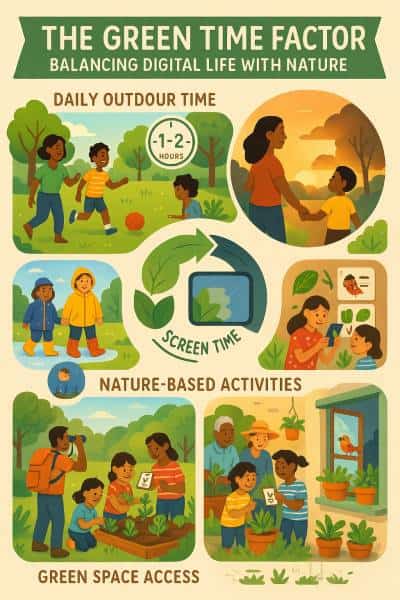 Research shows that “green time” (time in nature) can buffer the negative effects of screen use.
Research shows that “green time” (time in nature) can buffer the negative effects of screen use.
Implement these nature-based strategies:
-
Daily Outdoor Time
- Schedule at least 1-2 hours of outdoor play daily
- Create outdoor traditions (weekend walks, evening strolls)
- Maintain an “all-weather” outdoor policy with appropriate gear for all seasons
-
Nature-Based Activities
- Start a family garden or grow herbs
- Create outdoor scavenger hunts focusing on local flora and fauna
- Encourage nature photography or journaling in local parks
- Join conservation or environmental education programmes
-
Green Space Access
- Research local parks and nature reserves
- Visit nearby botanical gardens or community gardens
- Advocate for green spaces in your neighbourhood and schools
- Create mini-nature spaces with plants, even in urban environments
Modeling Healthy Technology Use
Children learn by watching adults. Practice these modeling strategies:
-
Be Present
- Put devices away during family meals and activities
- Avoid checking phones during conversations
- Demonstrate giving full attention to in-person interactions
-
Narrate Your Use
- Explain why and how you’re using technology
- “I’m looking up directions so we can find our way to the park”
- “I need to send this work email, then my phone is going away for family time”
-
Show Balance
- Let children see you enjoying non-digital activities
- Demonstrate healthy transitions away from screens
- Share your own screen time limits and boundaries
Teaching Digital Literacy
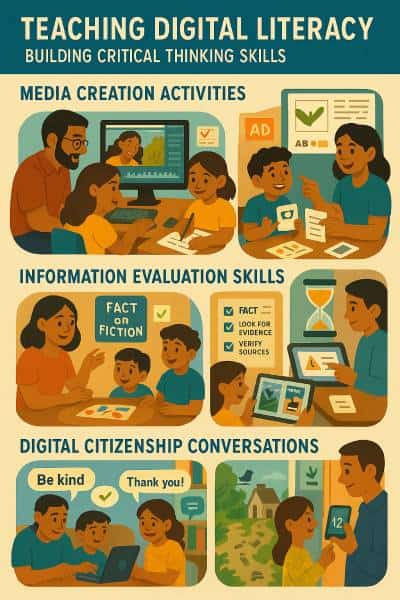 Help children develop critical thinking about media with these strategies:
Help children develop critical thinking about media with these strategies:
-
Media Creation Activities
- Create family videos or digital stories about meaningful topics
- Discuss how professional media is made and edited
- Analyse advertising techniques on television and streaming services
-
Information Evaluation Skills
- Play “fact or fiction” games with media content
- Teach how to verify information with trusted sources
- Use age-appropriate resources on misinformation
- Practice identifying scams versus legitimate content
-
Digital Citizenship Conversations
- Role-play online interactions using realistic scenarios
- Talk about digital footprints and privacy considerations
- Use school curriculum resources on digital citizenship
- Discuss cyberbullying prevention and online kindness
- Review age restrictions for social media platforms
Remember: Balance, Not Elimination
The goal isn’t eliminating technology but fostering mindful, intentional users who can:
- Use digital tools productively for education and connection
- Maintain meaningful in-person relationships alongside digital ones
- Recognise when technology affects their wellbeing
- Adapt to our evolving digital world with resilience
Helpful Resources for Parents
These organizations offer valuable resources, programs, and support for parents, educators, and children to promote digital wellbeing, healthy screen habits, and outdoor activities as alternatives to screen time.
Online Safety Organizations
- United States:
- National Center for Missing & Exploited Children: https://www.missingkids.org
- Common Sense Media: https://www.commonsensemedia.org
- Family Online Safety Institute: https://www.fosi.org
- Australia:
- eSafety Commissioner: https://www.esafety.gov.au
- Alannah & Madeline Foundation: https://www.amf.org.au
- Canada:
- MediaSmarts: https://mediasmarts.ca
- Canadian Centre for Child Protection: https://www.protectchildren.ca
- EU:
- European Network of Safer Internet Centres: https://www.betterinternetforkids.eu
- Insafe Network: https://www.saferinternet.org
- UK:
- Internet Matters: https://www.internetmatters.org
- UK Safer Internet Centre: https://saferinternet.org.uk
- NSPCC: https://www.nspcc.org.uk
- Childnet: https://www.childnet.com
Parenting Networks
- United States:
- American Academy of Pediatrics: https://www.aap.org
- Child Mind Institute: https://childmind.org
- Australia:
- Raising Children Network: https://raisingchildren.net.au
- Beyond Blue: https://www.beyondblue.org.au
- Canada:
- Canadian Paediatric Society: https://www.cps.ca
- Parents Canada: https://www.parentscanada.com
- EU:
- European Parents’ Association: https://europarents.eu
- Parents Europe: https://www.parentseurope.eu
- UK:
- Parentzone: https://parentzone.org.uk
- Young Minds: https://www.youngminds.org.uk
- NSPCC: https://www.nspcc.org.uk
Mental Health Resources
- United States:
- Child Mind Institute: https://childmind.org
- SAMHSA: https://www.samhsa.gov
- Australia:
- Headspace: https://headspace.org.au
- Beyond Blue: https://www.beyondblue.org.au
- Kids Helpline: https://kidshelpline.com.au
- Canada:
- Kids Help Phone: https://kidshelpphone.ca
- Centre for Addiction and Mental Health: https://www.camh.ca
- EU:
- Mental Health Europe: https://www.mhe-sme.org
- European Federation of Psychologists’ Associations: https://www.efpa.eu
- UK:
- Young Minds: https://www.youngminds.org.uk
- The Children’s Society: https://www.childrenssociety.org.uk
- Place2Be: https://www.place2be.org.uk
Nature & Conservation Programs
-
- United States:
- National Wildlife Federation’s Green Hour: https://www.nwf.org/Kids-and-Family
- Children & Nature Network: https://www.childrenandnature.org
- The Nature Conservancy: https://www.nature.org
- Australia:
- Wildlife Warriors: https://wildlifewarriors.org.au
- Junior Landcare: https://juniorlandcare.org.au
- Conservation Volunteers Australia: https://conservationvolunteers.com.au
- Canada:
- Nature Canada: https://naturecanada.ca
- Canadian Wildlife Federation: https://cwf-fcf.org
- Nature Conservancy of Canada: https://www.natureconservancy.ca
- UK:
- Wilderness Foundation: https://wildernessfoundation.org.uk
- Wildlife Trusts: https://www.wildlifetrusts.org
- Royal Society for the Protection of Birds: https://www.rspb.org.uk
- National Trust: https://www.nationaltrust.org.uk
- United States:
By implementing these practical strategies and emphasising balance between screen time and green time, you can help your children develop healthy digital habits that will serve them throughout life in our increasingly connected world. Research suggests that a majority of children exceed the recommended screen time guidelines, making it even more important to establish healthy digital habits early.
Author:
 | Lionel Thomas Father, Gamer and Founder with a Passion for Health, AI, Environment and Gamification of Life. |
Author Tools:
- ChatGPT (Content Enhancements & Research)
- Claude (Content Enhancements & Research)
- GSpeech (Audio by AI)
- Other Tools (AI)...
Artists:
- Lionel Thomas using DALL-E 3 [AI Generated] (Header, Content)
References:
Screen Time vs. Green Time: New Research on Children’s Well-being
Vitality For Gamers
https://www.vitalityforgamers.com/kids-h...
Summary:
Recent research shows children's screen time has increased significantly, with American teenagers now averaging over 5.5 hours daily on entertainment media. Studies from 2024-2025 reveal excessive screen use correlates with increased anxiety, attention problems, and developmental delays in children.
However, emerging research highlights "green time" (nature exposure) as a protective factor that can buffer these negative effects. Studies by Wang et al. (2024) and Liu et al. (2024) demonstrate that children with regular access to natural environments show reduced internet addiction risk and fewer depressive symptoms.
To establish healthy digital habits, experts recommend age-appropriate limits (no screens under 18 months except video chat; 1 hour maximum for ages 2-5), creating tech-free zones, prioritizing quality educational content, and modeling balanced technology use. The goal isn't eliminating technology but fostering mindful users who can recognize when technology affects their wellbeing while maintaining meaningful in-person relationships.








 Snacks
Snacks Water
Water Eye Sight
Eye Sight Hearing
Hearing














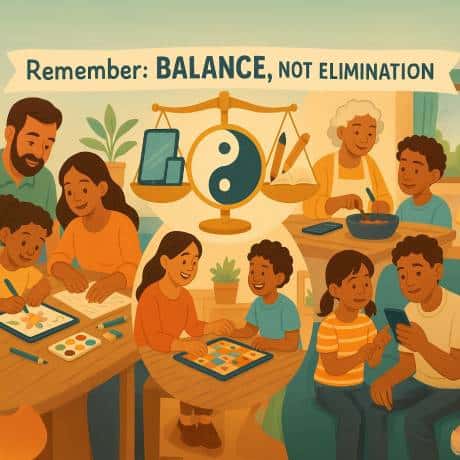

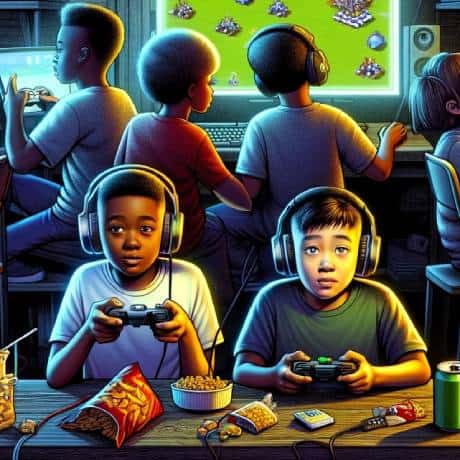






 Screen Time
Screen Time Play Sports
Play Sports


